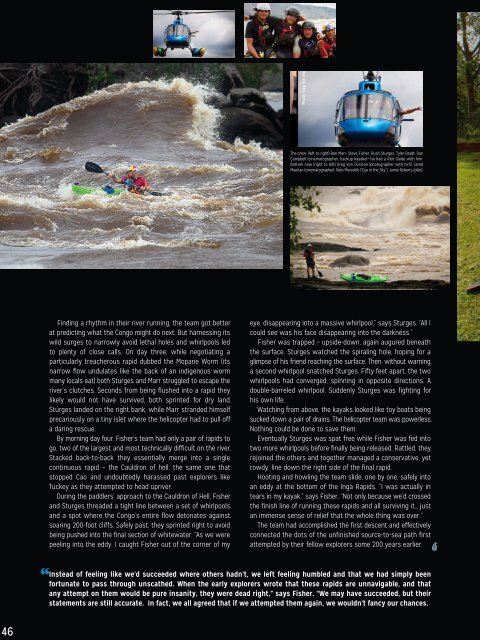River Karma
Typography project: Curated a typographic system that can be applied to various issues and structural spreads successfully where content influences the overall style and reading experience. Self created concept that focuses on grid and typographic hierarchy development pulling all articles and photographic sources from existing publications.
Typography project: Curated a typographic system that can be applied to various issues and structural spreads successfully where content influences the overall style and reading experience. Self created concept that focuses on grid and typographic hierarchy development pulling all articles and photographic sources from existing publications.
Create successful ePaper yourself
Turn your PDF publications into a flip-book with our unique Google optimized e-Paper software.
The crew, (left to right) Ben Marr, Steve Fisher, Rush Sturges, Tyler Bradt, Dan<br />
Campbell (cinematographer, backup kayaker--he had a Riot Guide with him.<br />
Bottom now (right to left) Greg Von Dorsten (photographer with him). Jared<br />
Meehan (cinematographer), Pete Meredith (“Eye in the Sky”), Jamie Roberts (pilot).<br />
Finding a rhythm in their river running, the team got better<br />
at predicting what the Congo might do next. But harnessing its<br />
wild surges to narrowly avoid lethal holes and whirlpools led<br />
to plenty of close calls. On day three, while negotiating a<br />
particularly treacherous rapid dubbed the Mopane Worm (its<br />
narrow flow undulates like the back of an indigenous worm<br />
many locals eat) both Sturges and Marr struggled to escape the<br />
river’s clutches. Seconds from being flushed into a rapid they<br />
likely would not have survived, both sprinted for dry land.<br />
Sturges landed on the right bank, while Marr stranded himself<br />
precariously on a tiny islet where the helicopter had to pull off<br />
a daring rescue.<br />
By morning day four, Fisher’s team had only a pair of rapids to<br />
go, two of the largest and most technically difficult on the river.<br />
Stacked back-to-back they essentially merge into a single<br />
continuous rapid – the Cauldron of hell, the same one that<br />
stopped Cao and undoubtedly harassed past explorers like<br />
Tuckey as they attempted to head upriver.<br />
During the paddlers’ approach to the Cauldron of Hell, Fisher<br />
and Sturges threaded a tight line between a set of whirlpools<br />
and a spot where the Congo’s entire flow detonates against<br />
soaring 200-foot cliffs. Safely past, they sprinted right to avoid<br />
being pushed into the final section of whitewater. “As we were<br />
peeling into the eddy, I caught Fisher out of the corner of my<br />
eye, disappearing into a massive whirlpool,” says Sturges. “All I<br />
could see was his face disappearing into the darkness.”<br />
Fisher was trapped – upside-down, again augured beneath<br />
the surface. Sturges watched the spiraling hole, hoping for a<br />
glimpse of his friend reaching the surface. Then, without warning,<br />
a second whirlpool snatched Sturges. Fifty feet apart, the two<br />
whirlpools had converged, spinning in opposite directions. A<br />
double-barreled whirlpool. Suddenly Sturges was fighting for<br />
his own life.<br />
Watching from above, the kayaks looked like toy boats being<br />
sucked down a pair of drains. The helicopter team was powerless.<br />
Nothing could be done to save them.<br />
Eventually Sturges was spat free while Fisher was fed into<br />
two more whirlpools before finally being released. Rattled, they<br />
rejoined the others and together managed a conservative, yet<br />
rowdy, line down the right side of the final rapid.<br />
Hooting and howling the team slide, one by one, safely into<br />
an eddy at the bottom of the Inga Rapids. “I was actually in<br />
tears in my kayak,” says Fisher. “Not only because we’d crossed<br />
the finish line of running these rapids and all surviving it… just<br />
an immense sense of relief that the whole thing was over.”<br />
The team had accomplished the first descent and effectively<br />
connected the dots of the unfinished source-to-sea path first<br />
attempted by their fellow explorers some 200 years earlier.<br />
Instead of feeling like we’d succeeded where others hadn’t, we left feeling humbled and that we had simply been<br />
fortunate to pass through unscathed. When the early explorers wrote that these rapids are unnavigable, and that<br />
any attempt on them would be pure insanity, they were dead right,” says Fisher. “We may have succeeded, but their<br />
statements are still accurate. In fact, we all agreed that if we attempted them again, we wouldn’t fancy our chances.<br />
46


